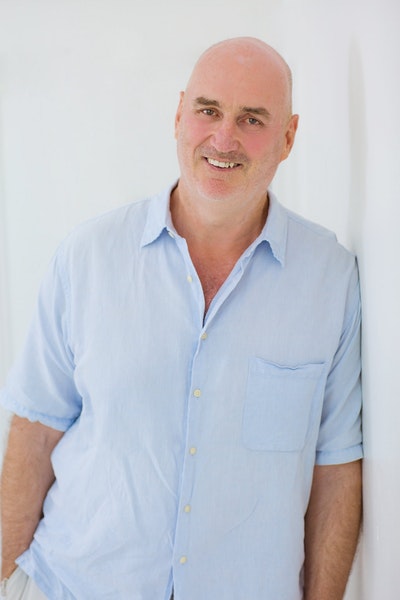Bestselling author of DEADLY, UNNA? on his latest coming-of-age YA novel, THE BREAK.
What inspired you to write The Break?
I lived in Bali from 2010 to 2016 and occasionally visited Australians incarcerated in Kerobokan Jail, including members of the Bali 9.
When the 2015 election was held I, like many other people, was hoping that Jokowi would prevail because I thought that, not being from Indonesia’s elites, he may have a more enlightened view on human rights and commute Sukumaran and Chan’s death penalties. As history tells us, exactly the opposite occurred, and on the 29th April 2015, on the island of Nusa Kambangan, they were executed by firing squad.
It was like a black cloud was hanging over the resort isle of Bali.
Sukumaran and Chan had been, by their own admission, wannabee gangsters, when they were arrested but they were completely rehabilitated, they were good men – kind, caring, thoughtful men, and, in Sukumaran’s case, possessed of huge creative talent.
As Myu wrote on the back of his portrait of Jokowi, ‘People can change.’
I knew then that I had no choice, that I needed to write about this.
It took me a long time, however, to find a way to do this.
There are many arguments against the Death Penalty, but the cruelty of knowing exactly when your loved one is going to die is, for me, almost the strongest one. I just didn’t want it to feel as if I was ‘exploiting’ the pain and suffering of those families.
Eventually I returned to very familiar territory for me, Young Adult fiction, where my first book Deadly Unna (also based on tragic real-life events) was published.
I created a character, 16-year-old Taj, who is an Aussie expat, a surfer, living in Bali. And it’s Taj’s father Kimbo who is in jail, who was busted for smuggling drugs ten years ago.
Which character do you relate the most to, and why?
In each and every character I create there is something of me. In Taj I recognise that feeling of powerlessness, of hopelessness, I experienced as a teenager (and still experience now!). In Kimbo I see a father who is keenly aware of the mistakes he has made and how they have impacted on his children. In Felicity there is that overwhelming need to love her child, and be loved in return. Kartika is adopted, and is searching for who she is, her place in the world. Again, I believe this is something we are all continually doing no matter how settled we may seem. Even in Jim, perhaps the least sympathetic character, I can see myself in his single-minded, almost reckless, determination.
Tell us about your favourite scene in The Break.
Ironically enough, one of my favourite scenes was suggested to me by my wonderful editor Claire De Medici. Taj and his father Kimbo are on the run and have managed to get a ride on a Phinisi boat; a traditional Indonesian sailing boat. After seeing a crew member shave with an old-fashioned cut-throat razer, Taj decides it’s a good idea to give his father a shave – and later a haircut! – to make him less recognizable. I love the intimacy, and trust, of the scene: on a rolling deck, with the sun disappearing, a father allows his son – who he hardly knows because he’s been in jail for the last 10 years – scrape away at his whiskers with a naked blade.
The Break explores some strong themes of kidnapping, prison, execution and grief. Why do you feel it is important to include these in books for teens and young adults?
Given that it was inspired – or provoked – by the execution of two young men, The Break was always going to be a book with strong bones. A book with something robust to say.
Actually, the first drafts of The Break were geared more to an adult audience, but as I developed it I began to realise that it was the younger characters who interested me more.
How did you approach the writing process for The Break? Did you need to do much research to build Taj’s world?
I lived in Bali for five years, have travelled extensively through Indonesia, and speak basic Bahasa Indonesia. I also visited some members of the Bali 9 in Kerobokan jail, so felt confident writing about conditions inside. Though I was appalled by Jokowi’s decision to execute Sukumaran and Chan, I also knew that did not necessarily represent the will of the Indonesian people. I know many Indonesians who were as saddened as I was by their senseless deaths. So it was important to me that I incorporated that into the book as well.
What is it about coming-of-age stories that captivates you most?
Writers love to write about turmoil, and for most people the most tumultuous time of their life is when they’re transitioning from children into adults.
I think this is especially true of Taj because he’s had a very privileged life, with maids and drivers, and in some ways he’s been prevented from accepting some of the responsibilities that come with maturation. But then he’s on the run with his father through the sprawling archipelago of Indonesia, with the Indonesian authorities after him, and the Australian authorities not necessarily welcoming him back home with open arms. Suddenly Taj has a whole lot of growing up to do.
What do you hope readers take away from The Break?
I think young people, who do not yet have the power to vote, can feel as if they have no political agency, as if everything is in the hands of, as Taj says in the book, ‘old men in bad suits’.
But in The Break, the young people prove that they can have agency, they can make a different. As the tagline says ‘Beat the system. Find the truth. Save a life.’















